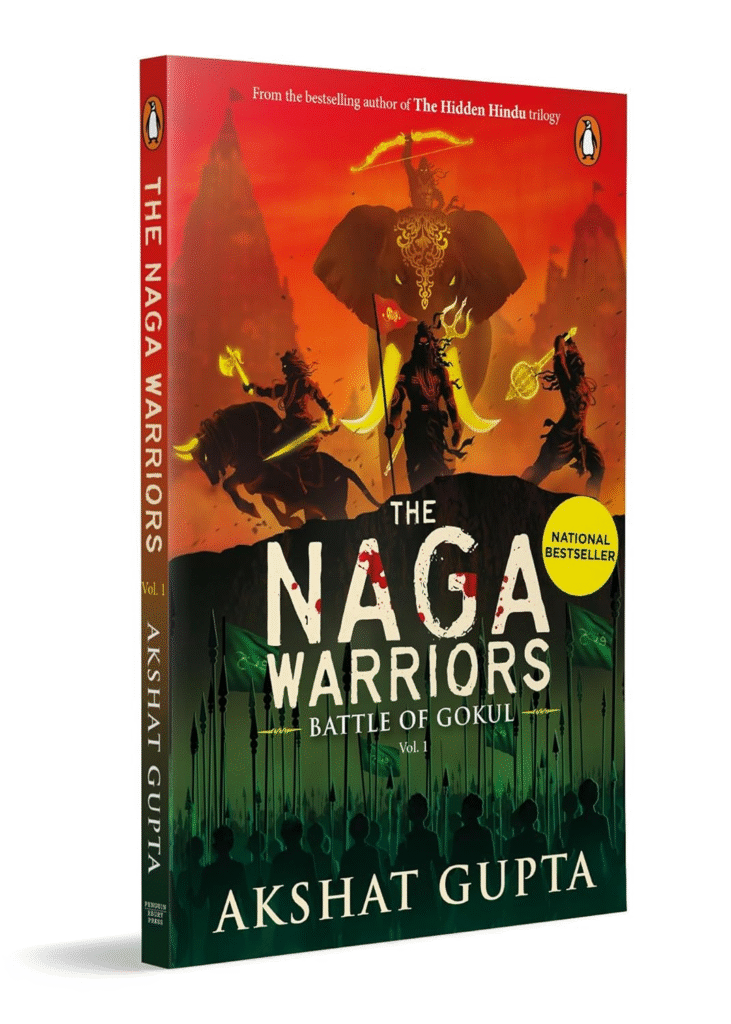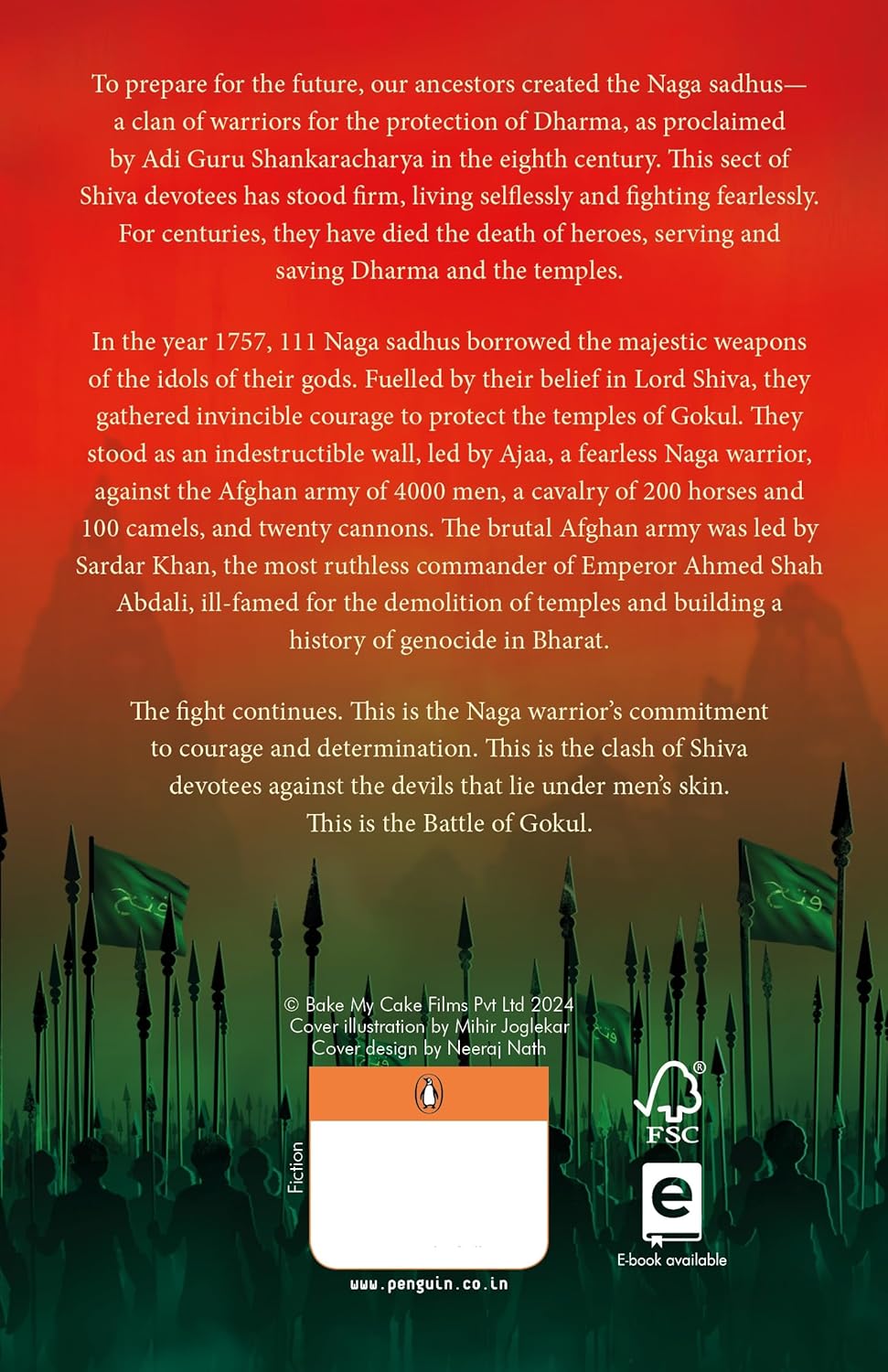The Naga Warriors: Battle of Gokul Vol 1, released in 2024, presents a gripping reimagining of a legendary battle deeply rooted in Indian history and mythology. The story brings to life the essence of courage, selfless sacrifice, and steadfast commitment to protecting Dharma. Written by Akshat Gupta, the bestselling author of The Hidden Hindu Trilogy, this novel dives deep into an epic and almost forgotten chapter of India’s spiritual and warrior heritage. Set in the year 1757, The Naga Warriors tells the thrilling story of 111 fearless Naga sadhus, Shiva devotees and fearless protectors of Dharma, who stood like an immovable wall against a massive and brutal Afghan army to defend the sacred temples of Gokul. The Naga Warriors brings to life a forgotten saga of valor, faith, and sacrifice in the face of overwhelming odds.

What makes The Naga Warriors stand out is how it blends mythology, history, and high-octane action into one unforgettable narrative. Through vivid descriptions and heartfelt moments, readers are drawn into the fierce battle led by Ajaa, a courageous Naga warrior, against the ruthless commander Sardar Khan. This clash between good and evil, faith and tyranny, makes for a story that is both inspiring and powerful.
The Naga Warriors is not just a tale of war; it is a tribute to unsung heroes, a celebration of ancient traditions, and a call to remember the values of selflessness, unity, and resilience. Akshat Gupta’s writing is simple yet cinematic, making it easy for readers to visualize the battles, feel the tension, and connect emotionally with the characters.
Whether you enjoy mythology-rich tales like The Shiva Trilogy or historical sagas like the Mahabharata, The Naga Warriors offers a fresh and exhilarating experience that honors India’s spiritual legacy. This is the kind of book that stays with you long after you have turned the last page.
Read Also: Wafadari Imaandari Zimmedari by Lt Gen Dhillon
Book Availability, Formats, and Pricing

The Naga Warriors: Battle of Gokul Vol 1 by Akshat Gupta, the bestselling author of the Hidden Hindu Trilogy, is available in both Hindi and English languages, catering to a wide range of readers. Published by Penguin eBury Press on 27 May 2024, this compelling mythological-historical fiction spans 256 pages in its paperback edition. Readers can choose from three formats Kindle edition priced at ₹155, paperback at ₹163, and an audiobook version available for free.
The book is easily accessible through major online platforms such as Amazon, Flipkart, and Penguin India’s official website. Whether you enjoy reading digitally, prefer holding a physical copy, or love listening to audiobooks, The Naga Warriors is available in a format that suits every reading style.
Read Also: Gods Guns & Missionaries by Manu S Pillai
About the Author: The Naga Warriors
Akshat Gupta is a dynamic and multifaceted Indian author known for blending mythology, history, and fiction into powerful narratives. Before stepping into the literary world, he successfully ran a restaurant chain, but his deep passion for storytelling eventually took centre stage. His breakthrough came with The Hidden Hindu trilogy, a result of two years of dedicated research and writing. The series quickly gained national recognition, becoming a bestseller and captivating readers with its unique fusion of Hindu mythology and modern themes.

Following the success of his debut series, Akshat expanded his creative vision with The Naga Warriors: Battle of Gokul Vol 1, the first book in a new series that pays tribute to the bravery of Naga Sadhus and the forgotten warriors of Indian history. His storytelling style is fast-paced, engaging, and rich in cultural context, making his books highly readable for a wide audience. Akshat’s strength lies in his ability to bring ancient traditions and forgotten episodes of Indian heritage into compelling fictional formats that resonate with today’s readers.
Beyond writing novels, Akshat Gupta is also a lyricist, poet, screenwriter, and motivational speaker. He has been involved in multiple public speaking platforms like TEDx and literary conclaves, where he shares his thoughts on Dharma, mythology, and storytelling. He is also actively working with well-known production houses in Mumbai to adapt his stories for screen, with several scripts currently in development for films and web series. His growing presence in the entertainment and literary world showcases his commitment to reviving Indian heritage through impactful storytelling.
With a clear vision and strong cultural grounding, Akshat Gupta continues to rise as one of India’s most influential contemporary writers. His work not only entertains but also educates and inspires, offering readers a deeper connection to the values, legends, and spiritual wisdom of Bharat.
Read Also: Caste Pride: Battles for Equality by Manoj Mitta
Thematic Analysis of The Naga Warriors
The first installment in the series centres around the fierce Battle of Gokul, where the courageous Naga Sadhus stood their ground against Sardar Khan, the ruthless general serving under Ahmad Shah Abdali. With a mission to devastate the sacred city of Gokul, Sardar Khan led a brutal invasion, but the fearless Naga warriors rose to defend their land and Dharma with unwavering resolve.

Although the book is written as a fictional story, it is based on a real historical event where the Naga warriors truly protected Gokul from the invading forces.
The story The Naga Warriors opens and concludes with a mysterious character known only as the nameless Naga. Set in the year 2024, the narrative begins when he saves a British climber trapped in an avalanche. While tending to the man’s injuries, the nameless Naga begins to recount the gripping events of 1757, leading into the legendary battle that forms the heart of the tale.
Among the standout characters are Ajaa, Shambhuji, Vanraaj, Mathadhish, and Dhruv each playing a key role in the unfolding drama. Ajaa, the fearless leader, and Shambhuji, the wise mentor, shine as truly admirable figures. Vanraaj brings an unexpected twist with his growth and bravery, while Mathadhish and Dhruv add depth and dimension to the story of The Naga Warriors. In stark contrast, the antagonist Sardar Khan is portrayed as a ruthless and merciless commander, heightening the tension and stakes of the conflict.
- The Unbreakable Spirit of Dharma: The Naga Warriors is deeply rooted in the timeless theme of Dharma. The book emphasizes that the preservation of righteousness is not just a duty instead it is a legacy. The Naga Sadhus stand as living embodiments of this principle, offering their very lives to protect sacred temples. Their unwavering dedication reflects the spiritual strength that has kept Indian civilization intact for centuries. Through their fierce loyalty, the story reminds readers that Dharma is not a passive belief, but an active force worth fighting for.
- Courage in the Face of Death: One of the most powerful themes in The Naga Warriors is raw, unshaken courage. The 111 Naga warriors knew they were walking into certain death when facing an Afghan army vastly larger in number and power. Yet they chose to stand firm. Led by Ajaa and guided spiritually by Mathadhish and Shambhuji, they embody the concept of Dharma as a call to action, choosing duty over life itself. This theme underlines that real bravery is not the absence of fear and it is the choice to face fear head-on for a higher cause. The warriors’ sacrifice becomes a testimony to what it means to be truly fearless.
- Mythology Blended with History: The book beautifully blends elements of Indian mythology with historical events. The Naga Warriors creates a unique narrative where mythological faith and historical resistance intersect. Readers are transported to 1757, a time when faith-driven warriors clashed with brutal invaders. This blend adds depth to the story, giving a spiritual lens to real events, while also celebrating the mythical power associated with divine weapons and sacred duties. Ajaa, the fearless leader inthis war is a central figure around whom the courage of the Naga warriors revolves. His strategic resolve and deep faith inspire his fellow warriors to stand firm against overwhelming odds 111 Naga Sadhus stand against an Afghan army of 4,000 soldiers backed by 200 cavalry, 100 camels, and 20 cannons. Despite being vastly outnumbered, the Naga warriors fight with unmatched discipline and resolve.
- Brotherhood and Loyalty: The bond between the characters especially Ajaa, Shambhuji, and Dhruv reflects an unshakable sense of brotherhood. In The Naga Warriors, loyalty is not just to a cause but to one another. These characters share more than battle strategy because they share emotion, pain, sacrifice, and belief. The theme of brotherhood reinforces the idea that unity is the greatest strength in times of war, and that fighting side by side with purpose turns men into legends.
- The Sacred Role of Spiritual Warriors: In The Naga Warriors, the Naga Sadhus are not portrayed as mere fighters but as spiritual guardians. They are monks, seekers of truth, and fierce defenders of sacred spaces. Their dual role combining asceticism with armed resistance adds a rare depth to their character. This theme explores the rare identity of the warrior-saint, someone who meditates by the Ganga one day and stands on a battlefield the next, fighting for a cause greater than themselves.
- The Power of Leadership: Leadership is another standout theme in The Naga Warriors Ajaa’s role as the leader of the 111 warriors is inspiring. His decisions are rooted in both spiritual wisdom and battlefield strategy. Shambhuji, the mentor and guiding force, brings calm and clarity. Their combined leadership highlights the importance of vision, sacrifice, and strength in guiding others through the chaos of war. It is a reflection of how strong leadership can change the course of history.
- Cultural Identity and Preservation: The fight in The Naga Warriors is not just about land and it is about identity. Gokul, a place of divine heritage, becomes the symbolic heart of a civilization under threat. The warriors’ actions represent a desperate yet heroic attempt to preserve not just temples, but an entire cultural and spiritual way of life. This theme emphasizes how preserving heritage and values is just as important as defending borders.
- Sacrifice and Legacy: The story glorifies the idea that sacrifice builds legacy. In The Naga Warriors, every warrior knows that their name may not be recorded in history books, but they fight regardless. Their selfless acts become seeds for future generations to remember and honour. The book powerfully conveys that true legacy is not built through fame or survival instead it is built through sacrifice and unwavering belief in a higher cause.
- The Strength of Faith: Faith is a guiding force throughout The Naga Warriors. The warriors draw their strength not from armor or weaponry, but from their belief in Lord Shiva. Their chants, rituals, and mantras are not mere traditions instead they are sources of courage. This theme reinforces the idea that faith can fortify the soul even when the body is at its weakest, and that true devotion can turn ordinary men into extraordinary heroes.
- Reawakening Historical Pride: Perhaps the most important theme in The Naga Warriors is the revival of forgotten history. By bringing to light the fierce battle of 1757 and the bravery of the Naga Sadhus, the book encourages readers to take pride in their roots. It challenges the silence around certain chapters of history and demands recognition for those who bled and died to protect the culture we now enjoy. This theme serves as a reminder that honouring the past is key to shaping a stronger, more aware future.
Why This Book Deserves Your Attention
Read Also: Joothan: A Dalit’s Life by Omprakash Valmiki

The Naga Warriors stands out for its simple yet powerful storytelling. Akshat Gupta uses clear, engaging language that makes the book highly accessible and even to readers who may not usually dive into historical or mythological fiction. The narrative flows smoothly, with a fast-paced plot and well-balanced emotional moments that keep readers hooked from beginning to end. Whether it is the tension of an impending battle or the quiet strength of spiritual rituals, every scene is described with vivid clarity.
What also makes this book so readable is the conversational tone woven into its structure, especially through the character of the nameless Naga Sadhu who narrates the story. His dialogues, thoughts, and teachings bring a human touch to the epic scale of the events, allowing readers to connect deeply with the themes of courage, sacrifice, and faith. The writing never feels overwhelming and it guides the reader naturally through complex ideas and intense action, making The Naga Warriors a gripping and approachable read for both new and seasoned lovers of mythological fiction.
Final Thoughts
The Naga Warriors is more than just a historical or mythological tale and it is a heartfelt tribute to the forgotten heroes who lived and died for their faith and land. Akshat Gupta creates a story that is not only rich in action and emotion but also rooted in cultural depth and spiritual relevance. The characters are well-developed, the pacing is tight, and the writing style makes the book approachable for all kinds of readers. From intense battle scenes to moments of quiet reflection, every chapter leaves a lasting impact.
This book revives an important chapter of India’s past with dignity and power, reminding us that stories of valour, unity, and Dharma still have the strength to inspire. Whether you are a fan of historical fiction, mythology, or stories of devotion and resistance, The Naga Warriors is a must-read that leaves you both enlightened and emotionally moved. It not only entertains but also instills a deeper appreciation for our spiritual and cultural legacy.
Read Also: How to Love in Sanskrit-Timeless Love Poems




